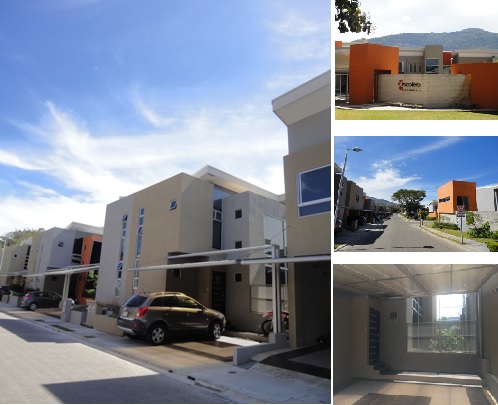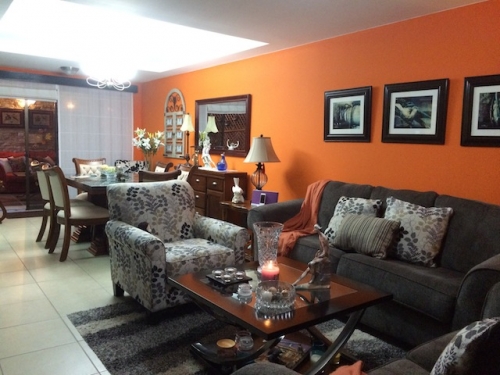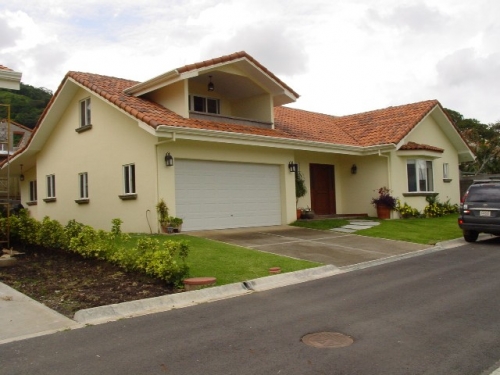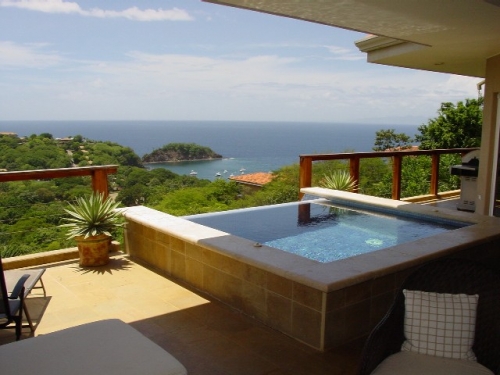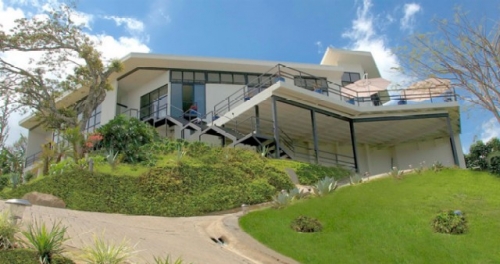Costa Rica Guide
Costa Rica Real Estate
List your property today!
Inclusion of real estate listings at Costa Rica Guide is
absolutely free of charge.
Featured Properties
Costa Rica Guide - Costa Rica Real Estate
A Protected Area's Importance and Performance:
The Barva Site of Braulio Carrillo National Park, Costa Rica
by:
Karen Parker, Department of Multi-Disciplinary Studies, University
of Nevada, Las Vegas, USA
Claudia Charpentier, Department of Biology, Universidad Nacional,
Costa Rica
Steve Dennis, Department of Natural Resources, California State
University at Chico, USA
Geralyn Dennis, Department of Natural Resources, California State
University at Chico, USA
May 1999
Braulio Carrillo National Park is the largest protected area dose to San Jose, the capitol city of Costa Rica. Within its 40,000 hectares of cloud forests, the Barva site remains relatively isolated and with difficult access. In comparison to the numbers of increasing numbers of tourist arrivals to other parks in Costa Rica, Barva is unique in that it has not experienced an explosion of popularity with ecotourists in recent years. All of this, however, is about to change: managerial objectives for Barva's future are based on increasing tourism with the intention to maintain integrity of the environment. Yet no impact studies have been conducted at Barva, nor have there been any inquiries made to identify its users. Visitor identification information is prologue to determining why, how and by whom the park is used, those experiential aspects of the facility which contributed to visitor satisfaction and dissatisfaction, and the overall performance of park management services and the park itself 'This study is based on the responses of 146 park visitors.
Introduction
The survey's results will be used to make recommendations the park administration should consider as they implement their tourism strategy, so as to provide excellence to visitors in the future as well as to prepare for those disturbances they will cause. This study is a preliminary step in implementing the Limits of Acceptable Change System (LAC, to be discussed in this paper further on) at the Barva site. This study presents the first data of its kind to be made available to management of the Barva protected area.
Conceptual Framework
The Secretary of The Environment, Energy and Mines (MINAE) has created an institution that is responsible for conservation in Costa Rica, the National Conservation Area System (SINAC). The country is divided into 11 Conservation Areas. Each one has a board for decision makings that includes community participants. These conservation areas consist of protected areas such as national parks, national forests and privately owned land as well. Each of the conservation areas is divided into sub-regions. The conservation area in this study is Cordillera Volcanica Central, the protected area is Braulio Carrillo National Park and the specific site is Barva Volcano located in the province of Heredia.
Visitor Profile
The fourth World Congress Meeting on Protected National Parks
in 1992 spotlighted the necessity of being conscious of who uses
protected areas as a direct means to precise and proper administration
of such areas (Courrau, 1997). Additionally, several authors (Butler
1991, Dowling 1993, Fennel & Eagles 1990, McIntyre & Boay 1995)
have addressed the necessity of tourist identification to determine
what they value in their chosen destination sites, as well as the
role this understanding plays in determining the sustainability
of the area. In order
approach issues concerning recreational use and maintenance strategies
in conjunction with the protection of those resources which attract
tourists in the first place, determinations of visitors' demographics,
motivations and other visitation data become critical players
in the approach park administrators adopt, as
'an inadequate understanding of tourist behavior and recreational
activity is compounded by incomplete knowledge or environmental
processes (Pearce, 1985).
Management
The Limits of Acceptable Change (LAC) System has been presented as model for environmental planners concerning those levels of change which management may deem appropriate for a wilderness area, though it may be applicable to a variety of settings. Composing its nine steps include methodologies for monitoring systems and indicators for identifying and objectifying specific, alternative opportunities for land use. One of its signature characteristics is that it "leads to a high level of customer satisfaction" (Munasinghe and McNeely, 1994, pp.267). Adopting the LAC process means that park administrators identify the precise types of wilderness conditions and aim to achieve these conditions, as they are very vulnerable to any number of impacts upon them, including the effects of nature recreation (Stankey, et. al, 1985). The management of the Barva site currently follows those guidelines and recommendations made by SINAC and is managed by taking into account recommendations made by the CAPAS model, a sophisticated environmental planning and monitoring tool sponsored by USAID for implementation throughout Central America, including the countries of Belize and Panama. In 1997 CAPAS produced the handbook for park managers in Central America which is now in use at Barva. (Courrau, 1997).
Importance
Visitors were asked to rate several environmental aspects and services which could contribute to visitors' enjoyment levels within Barva, aspects which the park administration could be able to change if needed (Campos, 1999).
Performance
The results to this category are based directly on the evaluation of how well the area performed in providing the aspects of the park that were important for the visitor.
Motivations
The Barva site is very rustic. Therefore, decisions concerning its visitation probably take its visual quality into account. For this study, visual quality is based on the products or satisfactions defined by Hull IV (1989).
Methodology
It was at the interface of the following situations that this survey was created:
Costa Rica has experienced a dramatic increase in its quantities of tourist arrivals within the past decade. A significant amount of these tourists' motivations for choosing Costa Rica as their travel destination pertains to the uniqueness of its National Park system and the political stability of its government, as tourism development is increasingly perceived as being in harmony with the total environment (Arias, 1989). While visitor identification research has been conducted in Costa Rican National Parks, nothing is known about those who do come to the Barva site.
Description of site
The Barva site of the Braulio Carrillo National Park is located 22 kilometers north of the capital city of San Jose. The land within its southwestern area has 4 volcanic peaks, one of which measures 2,840 meters. The now-dormant Barva Volcano is a main attraction to that area. Its volcanic eruptions have not occurred for some 3,000 to 5,000 years. Another part of this secluded area includes a mountain range containing a trio of peaks commonly known as The Three Marys, which stand at 2,900 meters. Barva has a cloud forest and several riparian settings where numerous rivers and streams spring. It is a habitat for the Quetzal, as well as many other birds, mammals and reptiles (Valerio, 1999).
A former administrator of the area stated that, by law, a diameter of 2 kilometers around all craters in Costa Rica were declared to be national parks. However, the Barva volcano was not considered a national park while neighboring volcanoes, Iraizu and Poas were. Due to the difficulty of access and the protection of some of the land owners, Barva was kept in relatively good condition and was officially acknowledged as part of a national park in 1978 (Herrera, 1999).
Research Objectives
- Determine a relevant profile of visitors to Braulio Carrillo National Park within its Barva Site during the high-tourist season.
- Determine the importance and performance of site-specific park qualities, in addition to the visitors' perception of park management.
- Produce information from this study in order to make recommendations to be taken into consideration for a future park management plan for the Barva site.
Research Design
According to Ritchie and Goelner (1994, pp.15) this type of research follows under the category of managerial research. The authors attempted to determine if visitors to the Barva site perceived a need for changes, including those in infrastructure. Some decision-makers in this park's administration believe that Barva should be similar in those services and infrastructure offered at Poas National Park (Campos,1999).
The single research instrument used was a written questionnaire available in the English and Spanish languages, given to participants at the end of their visit to the park for completion. Using bilingual English and Spanish speakers, the instrument was pre-tested for language continuity before being distributed. Each survey respondent was presented with a list of 14 different potential motivations for coming to the park. Each of these questions used the 5-point Likert scale, where 5 indicated that the respondent would "strongly agree," 4 indicated that he/she "agrees," 3 indicated "neither agrees nor disagrees," 2 indicated he/she "disagrees" and 1 indicated he/she "strongly disagrees."
The importance of aspects which provided a pleasant visitor experience were determined with 14 variables. These were measured with a 5-point Likert scale which ranged from highest importance (5), strong importance (4), importance (3), low importance (2), and not of importance (1).
Performance of the aspects of the park were determined using a 5-point Likert scale, ranging from excellent performance (5), good performance (4), satisfactory importance (3), unsatisfactory importance (2) and poor performance (1). Following this, a set of 21 items were presented in the survey which measured the importance of some recreational activities and forms of infrastructure that MINAE is considering to add to the park.
Visitors were able to state how important each potential recreational implementation would be to their level of future enjoyment of Barva. This section was based on the same 5-point Likert scale that was used in the importance identification questions. For each question that employed the Likert scale, only those responses with means higher than 3.50 were considered to be of greatest significance to the study.
Contact Methodology
Due in part to information on visitor response rates and human interaction in Latin America (Mintzer & Swift, 1994), at least one person was consistently needed to administer survey distribution. One researcher was on-site to hand out surveys to visitors on Fridays, Saturdays and Sundays, and park rangers distributed them from Tuesday until Friday afternoon, when a researcher would arrive. The Barva site is closed on Mondays. Its hours of operation are 8 a.m. to 4 p.m..
Sampling
Survey distribution began on February 5, 1999, and was completed
on April 7, 1999, within the time frame considered to be Costa Rica's
high tourist season. Because the Barva site receives so few
visitors, questionnaires were given to each willing person alone
or in visitor groups with no discretionary basis.
Research Findings and Discussion
Profile of Visitors
Means of arrival
A total of 124 visitors contributed to this study. 48% were female and 52% were male. The mean age was 28 years old. 53.4% of the visitors arrived on foot, 17.8% by bus, 24% by car, 2.1 by taxi, 1.33% by rental car and 1.37% in an official vehicle. The results show that visitors were young adults that walked relatively long distances and harsh roads to get to the park.
Education Levels
Trends in this category indicated that 78% visitors had experienced some level of university education, 33.9% who had not yet completed these studies.. The highest level of education for 17.3% of users was graduation from college. 11% had completed Masters' degrees, and 7.9% had obtained doctorate or post-doctorate degrees. 15% of the users had graduated from high school, 3.9% from a technical high school, and 3.1% from elementary education. These results are in agreement with Hendee's (1990) and others (Roggenbuck and Lucas, 1987) evaluations of nature recreationists' education levels. There was no difference for education levels of Costa Ricans compared with those education levels of users from other countries.
Nationality
Costa Ricans are the area's primary users, most of them living in the province of Heredia. 66.4% of respondents were from Costa Rica, 61% of which were residents of Heredia. 33.6% were from other countries. Among the foreigners, the highest percentage (19.5%) was from the United States.
Motivations
| Variable | Mean | SD |
| Enjoy a natural setting
Be physically active Be outdoors Learn about nature Get away from the daily routine Be with my friends Relax Have peace and quiet Participate in park activities Have a picnic Meet new people Be with my family Play a sport Drink alcoholic beverages |
4.51
4.31 4.30 4.22 4.19 4.09 4.01 3.83 3.47 3.44 2.98 2.30 2.38 1.53 |
1.01
0.93 1.28 1.07 .99 1.28 1.22 1.49 1.33 1.34 1.49 1.60 1.51 1.23 |
The motivations users most strongly identified with their visit are presented in Table 1. According to Hull (1989, pp. 486-487) the descriptions of 'products' or benefits to be derived from the visual quality of a recreational attraction are. quality of outdoor recreation, emotion, appearance of forest, mental and physical health, among others. The study shows, that of the products of visual quality, those items related to emotional reaction had the highest agreement scores. Perhaps the products of the Barva experience are outside the range of feelings a person experience on a daily basis. 'Enjoy a natural setting' had the highest score (4.51) and 'relax' (4.01) was also important. Another product that was relevant for the visitors was their physical health. Items to be considered in this category are 'to be physically active' (4.31) and to 'be outdoors' (4.30). The last product, considered important for this study was mental health. Visitors reported going to the Barva site in order to 'get away from daily routine' (4.19) and to 'be with friends' (4.09), both of which elicit emotional responses not felt on a daily basis. These motivations should not be ignored as indeed "parks are ultimately social constructs; they are inventions created by society as a means of ensuring certain values deemed important that society, including recreational, scientific, educational and economic. To misunderstand or ignore the social definitions underlying such areas is, ironically, to jeopardize the very values for which they were created" (McCool and Stankey, 1993).
Results show that visitors revealed that a key outcome for that day was to experience "a natural setting". This is a remote location with a main trail that is relatively steep when hiking towards the lake and volcano area, it is not surprising that visitors ranked to "Be physically active" as the second-highest motivation for visiting the site. The fact that most people arrived with at least one other person, shows that acquaintances seek to share this wilderness space together in search of friendship.
It is clear that visitors do not go to this site to be with their families, and they are not interested in playing sports or drinking alcoholic beverages. Barva is a place visited to enjoy the magnificence of the volcano, its lake, flora and fauna.
Management
| Variable | Mean | SD |
| A natural setting
Lack of litter No vandalism Silence and tranquility Nature Trails Aesthetics Courtesy of park rangers Trail Maintenance Rain shelters Availability of restrooms Ability to contribute donations Very few trash cans Ability to contribute by volunteering Not seeing/hearing other people |
4.67 4.63 4.59 4.56 4.48 4.35 4.31 4.25 3.83 3.70 3.69 3.47 3.33 3.14 |
0.08 0.73 0.95 0.74 0.80 1.03 0.86 0.92 1.24 1.33 1.23 1.28 1.34 1.35 |
People placed the highest level of importance on attractors such as the natural setting, nature trails, aesthetics silence and tranquility, courtesy of park rangers, trail maintenance, rain shelters, availability of restrooms, and ability to contribute to the park through donations (Table 2). Results found in this study agree with McCool and Stankey (1993) in terms of the importance of having nature trails to protect habitats from tourist impacts. Participants also gave importance to the absence of detractors such as litter and vandalism. The results of importance of park aspects considered as attractors increased the enjoyment of visitors. This finding can be complemented with the comments they wrote at the end of their surveys, in which some visitors recommended to "keep the park as it is now" and "congratulate park rangers for the excellent work in preserving the environment.
| Variable | Mean | SD |
| Silence and tranquility
Natural setting Aesthetics No vandalism (no grafitti, robbery) Lack of litter Courtesy of park attendants Nature trails Availability of restrooms Trail maintenance Rain shelters Very few trash cans Ability to contribute donations Not seeing/hearing other people Ability to contribute volunteering |
4.60 4.57 4.54 4.53 4.51 4.49 4.23 4.12 3.98 3.95 3.90 3.90 3.68 3.49 |
0.65 0.67 0.80 0.81 0.72 0.76 0.99 0.96 0.94 1.11 1.11 1.04 1.14 1.19 |
From the high levels of importance that visitors gave the Barva site, it could be said that the performance of these variables was also of good quality. The singular variable which performed lower by this study's standards was the ability to contribute to the park through volunteering. This variable's score correlates with the reality of the nonexistent volunteer situation at the Barva site. It was also ranked among the lowest variables in visitor importance as well. It is at this point that the study's results concerning a volunteer advisory board become relevant. When asked about serving as a volunteer on a park advisory board, 66.7% indicated no and 33.3% indicated yes. Those who answered positively were asked to fill out a contact card attached to the last page of the survey.
Looking at the results, eight out of fourteen aspects were rated with good performance (Table 3). Among the highest values were: silence and tranquility, natural setting, and aesthetics. From the perspective of visitors, this means that importance and performance of the site, is contributing to the overall enjoyment of tourists.
One variable that ranked low in both importance and performance was "Ability to contribute to the park through donations". The reason for this result is that current laws prohibit on-site donations. Donors must go to MINAE's headquarters in San Jose to make any and all contributions. This system is very limiting for those visitors who do not have the time nor the desire to go to MINAE's.
The study shows that visitors to the Barva site give importance to attributes that are maintained by people with environmental values. Using Rokeach and Cadutto's (1985) environmental value classification, these are: a love for people- most visitors were in groups of two or more'; a love for the Earth; a world of beauty- high scores of importance and performance were given to both a natural setting and aesthetics, and Barva visitors recommended that very few interventions be made by park management, a result of which may not dramatically affect the balance of the ecosystems there.
Desirability of Future Site Aspects
| Variable | Mean | SD |
| Trashcans
Garbage collection Lookout points Maps Environmental interpretation Rooms Easy access to the park Restrooms Printed materials Nature guides Children's play equipment Picnic tables Adequate parking Beverage sales Horseback rides Food sales Barbecue grills More rain shelters Open play areas Sports courts Soccer fields |
4.33 4.11 4.06 3.99 3.97 3.74 3.71 3.66 3.58 3.50 3.36 3.15 3.02 3.00 2.85 2.79 2.58 2.54 2.37 2.02 1.95 |
1.10 1.19 1.07 1.09 1.09 1.42 1.35 1.39 1.29 1.25 1.51 1.34 1.56 1.47 1.47 1.41 1.52 1.24 1.39 1.45 1.45 |
These results tend to agree with both the current facilities at the Barva site and the profile of its visitors. Respondents placed the most importance to having more trash cans and garbage collection available. During the study litter was collected from trails, and perhaps the visitors think that an increase of garbage collection and trash cans would reduce or eliminate the problem. The fact that these were given importance by visitors could imply that they perceive litter as a potential problem in the park. Before more trash cans are installed, an educational campaign should be started in order to increase visitor awareness concerning the final disposition of their trash. At this moment, there is no public system for garbage collection, and no solution its in the near future. Therefore, the pack-it-in, pack-it-out philosophy should be encouraged for visitor behavior at this site.
Three items that could represent changes in the park which were recommended were lookout points, rooms and restrooms. These results partly agree with infrastructure suggested in the Diagnosis of Braulio Carrillo National Park (Zuniga, 1998, pp.25). Park managers recommend to build a basic shelter, a visitor center with simple research facilities. These constructions will provide rooms and restrooms which complement views of visitors.
Currently there are only two lookout or 'scenic view-' points and one bathroom accessible. There are no types of rooms available for overnight use at this time. However, camping is permitted with a maximum capacity of 25 visitors.
Visitors also encouraged the adoption of more trash cans to the site, and gave high importance to garbage collection. As Barva currently exists, there are only 3 trash receptacles which visitors have access to. A need for more information and educational materials was also important. Visitors placed a moderate degree of importance on maps and environmental interpretation, as well as printed materials.
Park Management Issues
Visitors' perceptions of entrance fees
75% of visitors felt that the park entrance fee of ($6.00 for foreigners, $1.25 for residents and exchange students) was fair, while 16% believed it was very high and 8.5% believed it was very low. 63.7% of visitors believed that the money the park received from entrance fees contributed to keeping it well-maintained. 11.3% of people disagreed with this philosophy, and 25% were indifferent. According to managerial dispositions in MINAE, entrance fees received by all parks are channeled directly into one general park general management fund.
One question of importance to the MINAE agency is visitors' willingness to pay more in entrance fees in the future. (cite) This determining questioned was written as "If additional money was put directly back into this park and if the increase was fair to me, I would be willing to pay more to visit the park." Some 30.4% responded negatively, but the majority of visitors, 69.6%, responded positively. Of those 69.6% of visitors, 25% stated they would pay an increase of $0.55. 22% would pay $1.10 more, 22% would pay $1.38 more, 22% would pay $2.20 more, and 8.3% would pay $5.00. Any recommendations which could be made from the aforementioned information would be futile due to the current funding structure in place by park management. As already stated, one general fund for park management is responsible for receiving and allocating all park entrance fees. Therefore, even if the Barva site were to increase its entrance fees, this would not guarantee that more funding would then be allocated for its many services.
The site managers should be able to comply with the recommendations made by Courrau (1997, pp.3), which stated that "obtaining and organizing relative information to the natural processes, as well as changes in a protected area is of extreme importance for a person that makes decisions. Whatever activity that took place within a protected area must be monitored in order to prevent negative impacts in natural and cultural resources, and also as to maximize positive changes."
Recommendations
Based on the results of the study, the authors propose that the following recommendations be taken into consideration:
- Create a managerial plan that utilizes the LAC process. Monitoring Systems, indicators and outcome-based wilderness goals should be used in future managerial strategies at the Barva site. In this process, all segments recommended by LAC should be included.
- The limited infrastructure of the Barva site appears to be one of the features that attracts this kind of visitor. Therefore, these authors suggest that only minimal changes are made in infrastructure so as to improve those services offered. These would be for the installation of basic, overnight shelters and an addition of bathrooms.
- Efforts should be made to improve the conditions of the point of access to the area, but again using caution. Consider a gravel road rather than a paved one. Also, some visitors would appreciate an improvement of parking facilities.
- An educational campaign should accompany the installation of trash cans which would promote 'No Littering' guidelines along with a pack-it-in, pack-it-out philosophy.
- The management of the Barva site must include the input of and participation of local people. The fostering of both a citizen advisory board and a volunteer committee are strongly encouraged. Local peoples' knowledge on, and opinions concerning, the future of tourism in their neighborhoods need to be heavily weighted by park and tourism planners in the future.
- Managers of the site need to promote and create a permanent volunteer program that could assist with accomplishing with many of those functions (such as monitoring visitor behavior) which could benefit the park, especially during the high-tourist season.
Further Research Needed
This study had very specific objectives. However, as data and existing trends concerning the Barva site, the local community, the visitor profile and the plans of the park management continued to unfold, these authors realized that many other studies are needed here. These include environmental, cultural and psychological impacts of increased tourism to this area.
Another survey of this type is recommended, but to last for a longer period of time, and to include both the high- and low-tourist seasons.
References
Arias, 0. (1989). Tourism, a vital force for Peace. Tecnitur International 22: 8.
Butler, R.W. (1991). Tourism, Environment and Sustainable Development. Environmental Conservation. Vol.18, (3) Pp: 204-5.
Courrau, J. (1997). Estrategia de Monitoreo de Areas Protegidas de Centro America. Proarca/CAPAS, CCAD-USAID. pp.2-18.
Dowling, R. (1993). An environmentally-based planning model for regional tourism development. Journal of Sustainable Tourism. 1(1): 18-23.
Driver, B.L., Brown, PJ., Stankey, G.H and Cregoire, T.G., (1987). ROS planning system: evolution, basic concepts and research needed. Leis. Sci 9(3). pp.201-12.Fennell,
D., & Eagles, P. (1990). Ecotourism in Costa Rica: A Conceptual Framework. Journal of Park and Recreation Administration. 8 (1), pp.23-43.
Hendee, J.C., Stankey, G.H. and Lucas, R.C. (1990) Wilderness Management,. Golden, Colorado. North American Press. pp.379.
Hull IV, R.B. (1989). Forest visual quality management and research. Outdoor Recreation Forum. USDA For Serv. Gen. Tech. Rept. SE-Si. Asheville, NC: Southeastern Forest Exp. Sta.
Lumsdon, L and Swift, J. (1998). Ecotourism at a Crossroads: The case of Costa Rica. Journal of Sustainable Tourism, 6 (2) pp. 155-161.
McIntyre, N. And Boag, A. (1995). The measurement of crowding in nature-based tourism ventures: Uluru National Park. Tourism Recreational Research Vol. 20 (1). pp. 37-42.
Mitchell, M.V. (1993). Forest Places Incorporating special spaces management. Journal of Forestry Edition 4, pp.32-37.
Munasinghe, M. and McNeely, J. (1994) Protecteea Economics and Policy: Linking Conservation and Sustainable Development. Washington, D.C.: The International Bank for Reconstruction and Development/The World Bank. pp.267-8.
Pearce, D.G. (1985). Tourism and Environmental Research: A review Journal of Environmental Studies, Volume 25. pp: 248-250.
Ritchie, B. And Goeldner, C. (1994) Travel and Tourism Hospitality Research; A handbook for managers and researchers. New York, John Wiley and Sons, Inc. pp.15.
Roggenbeck, J. And Lucas, R. (1987). Wilderness use and user characteristics: a state-of-knowledge review. CO. Gen. Tech. Rep. INT-220, Ogden, Utah: US Dept. of Agriculture, Forest Service, intermountain research station. pp. 204-5.
Stankey, G., Cole, D. Lucas, R. Peterson, M. and Frissell, 5. (1985). The Limits of Acceptable Change (LAC) system for wilderness planning. Gen. Tech. Rep. INT- 176. Ogden, Utah: US Department of Agriculture, Forest Service, Intermountain Forest and Range Experiment Station. pp. 5-14.
Stankey, G. and McCool, 5. (1992). Management for the sustainable use of protected wildlands: The limits of acceptable change framework. IV World Congress on National Parks and Protected Areas, Caracas, Venezuela, February 10-21, 1992.
Zuniga, C. (1998) Diagnostico del Pargue Nacional Brauho Carrillo. San Jose, Costa Rica. Ministerio del Ambiente y Energia. Sistema Nacional de Areas de Conservaci6n. pp.39.
Interviews
Campos, M. (1999) Administrator of the Barva Site, Braulio Carrillo National Park, Heredia, Costa Rica. April 14.
Herrera, H. (1999). Former Administrator of the Barva Site, Braulio Carrillo National Park, Heredia, Costa Rica. April 22.
Valerio, F. (1999) Director, Sub-region Heredia, Area de Conservaci6n Cordillera Volcanica Central. Heredia, Costa Rica. April 19.
©First Pan-American Conference
Latin American Tourism in Next Millenium: Education, Investment
and Sustainability
May 19-21, 1999 / Panama City, Panama
Editor: Professor Kaye Chon, University of Houston
Note: The above information is not to be used for any other purpose other than private study, research, criticism or review. Thank you.

